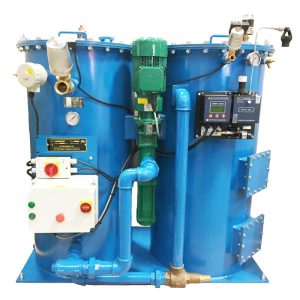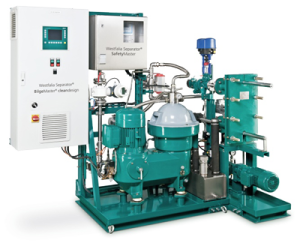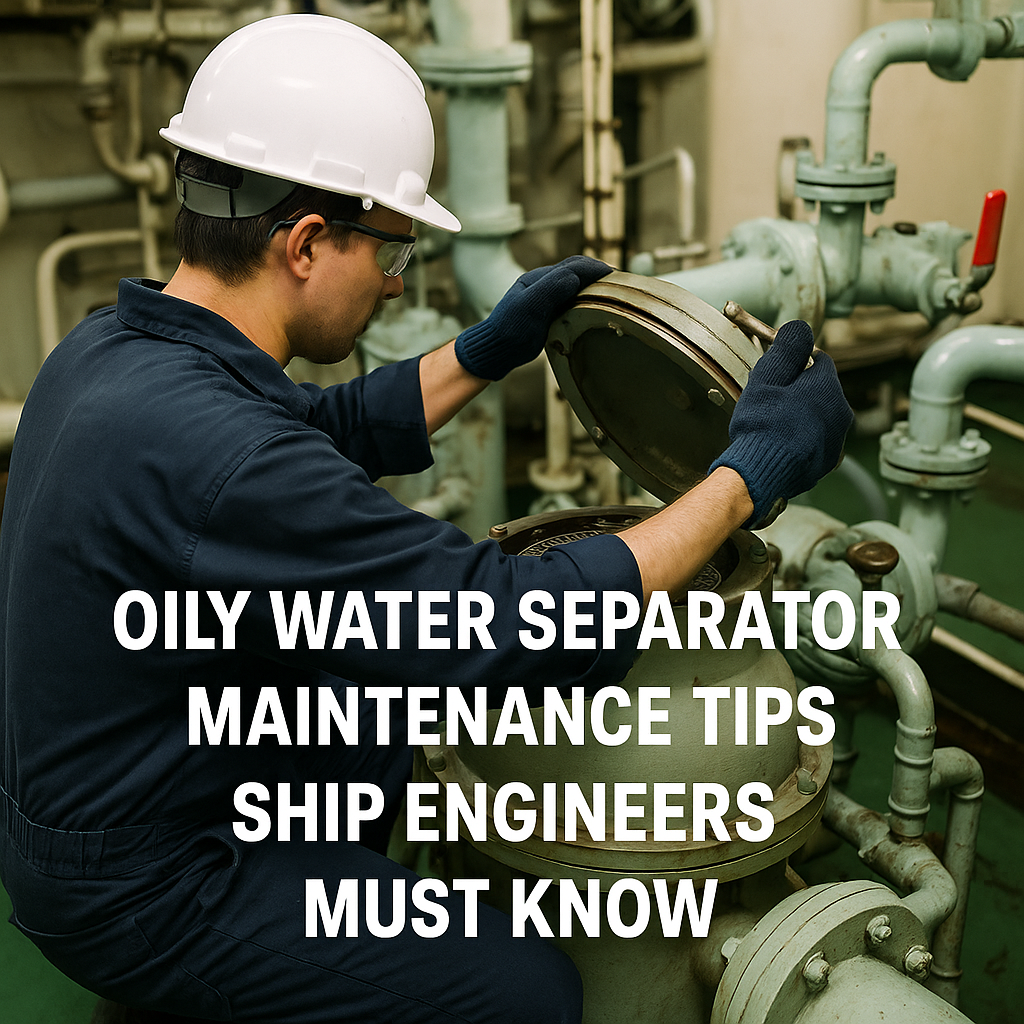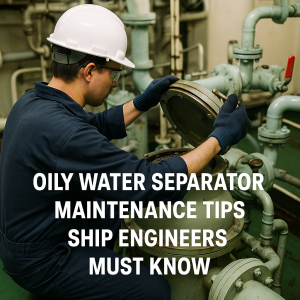Discover the top 12 oily water separator maintenance tips that ship engineers must know to stay compliant and efficient. Learn best practices, real-world insights, and expert guidance for environmental safety.
Oily Water Separators (OWS) are the unsung heroes of marine engineering. Hidden away in the engine room, they quietly protect our oceans by removing oil from bilge water and keeping us within the strict 15 ppm discharge limit set by MARPOL Annex I, Regulation 14 . But beyond the regulations, proper OWS upkeep is essential for operational reliability, cost-efficiency, and the safety of your crew and vessel. This guide delivers 12 human‑friendly, professional tips—driven by real-world examples and regulatory insight—to help engineers elevate their maintenance, boost compliance, and stay ahead.
- These separators rely on the principle that oil is less dense than water and will float to the top when given sufficient time and surface area.
- They often incorporate coalescing plates to help small oil droplets combine into larger ones, making them easier to separate.
- A typical gravity OWS will have a series of plates or baffles that the oily water mixture flows over, allowing oil to collect and rise to the top for removal.
- Some designs incorporate a second chamber for further filtration or polishing of the water before discharge.

- These separators use centrifugal force to rapidly separate oil and water.
- Oily water is fed into a rotating chamber, and the heavier water is forced to the outer edges while the lighter oil collects in the center.
- This method is faster and more efficient than gravity separation, especially for emulsions or very fine oil particles.

Why OWS Maintenance Is Crucial in Modern Shipping
OWS systems lie at the heart of clean bilge operations. Without them, ships risk major fines, PSC detention, and even criminal penalties . Plus, equipment failure means expensive repairs or, worse, vessel downtime. From an environmental standpoint, frequent failure pollutes coastal waters and damages a ship’s reputation.
Marine Insight reports that most tampering issues stem from deteriorating components, clogging, or bypass attempts . Stopping these issues before they start is both smart and responsible.
Frequent Flushing and Clean-Outs Keep the System Running
Regularly flushing the OWS—weekly or per manufacturer guidelines—prevents sediment buildup. A dedicated flushing circuit allows for easier deep cleaning without halting operations .
Real-world scenario: A tanker crew found their separator filter fouled solid after just five days of operation without flushing—regular cleaning restored full function and prevented PSC alarms.
Daily Visual Bedsides Detect Problems Early
Start each day with a quick visual check: examine pipes, sampling points, valves, coalescer cartridges, and alarm loops for leaks, corrosion, or damage. Prompt fixes save big headaches. Replace gaskets and O‑rings immediately when leaking, and inspect the vertical sampling pipe—MARPOL requires this to meet inspection standards DNV.
Maintain Proper Bilge Water Viscosity and Quality
OWS systems expect water viscosity within certain levels. Pre‑treat heavy bilge water—like hydraulic fluid drips—using settlement tanks or separators before sending it to the OWS . Also, clean bilge suction strainers daily to stop solids from entering the separator .
Monitor and Clean the Oil Content Meter (OCM) Smartly
The OCM uses light-scattering to maintain <15 ppm .Yet it can fail under fouling or air bubbles. Weekly sensor cleaning, either by fresh water flushing or using a bottle brush, sharply improves accuracy .
Also inspect the tamper-proof white‑box enclosure housing the OCM, flow switch, and flow meter . Any sign of tampering or corrosion must be fixed immediately.
Test Sampling Points and Bilge Alarms Monthly
Check sampling taps and alarm piping monthly for correct vertical placement per MEPC 107(49). Then test alarms and the three‑way valve to verify the system halts discharge if oil content exceeds 15 ppm.
Replace Filter and Coalescer Media on Time
Cartridges, organoclay or sand demands scheduled replacement—usually every 3–6 months, depending on bilge contamination . A fouled filter not only fails compliance, it shortens equipment life.
Calibrate Flow Meters, Sensors, and Pumps Quarterly
The OWS’s flow meter, pressure sensors, and pump performance directly affect separation quality and log data integrity . Quarterly calibration ensures discharge volumes match logbook records and that PSC audits pass smoothly.
Keep Spares Onboard—Prepare for Worst-Case
Key spares include filter cartridges, OCM cell, valves, and gaskets . Having them ensures downtime is minimized. One cruise line saved €200k after repairing a leaking coalescer during a port call and avoiding delays.
Keep Records Beyond the Oil Record Book
PSCs scrutinize the Oil Record Book, but keep your own maintenance log, including date, actions taken, parts replaced, and results. Add calibration records and alarm events. These documents show diligence and readiness during audits .
Train Crew and Cultivate Reporting Culture
The International Chamber of Shipping strongly advises zero-tolerance, robust crew training, and open communication to uphold compliance . Regular onboard drills ensure swift action during alarms, sampling, or fouled OCM events.
Inspect for Bypass Risks via Design and Automation
Ensure no pipe bypass around the separator exists—even unintentionally . Check that recirculation is impossible and that mechanical flow-switch systems prevent oil bypassing the OCM. A bypass found on one vessel led to mass fines—prompt retrofit fixed it.
Stay Updated with IMO and Classification Society Guidelines
Stay current with MEPC resolutions, IMO revisions (e.g., MEPC 107/285), and classification updates regarding sampling point arrangements . Every year, regulations evolve—don’t be caught out by outdated arrangements.
–
Case Studies: Real-World Lessons
Case 1: Tanker PSC Detention
A tanker had OWS sampling piping installed horizontally upstream—non‑compliant with MEPC 107(49). PSC detained the vessel until rework—a cost of several thousand dollars. Simple vertical loop installation would have avoided it .
Case 2: Cruise Line Audit Success
A cruise vessel had a detailed OWS logs archive, including weekly flushing and calibration. When audited, inspectors praised “keeping the white box data even during sensor cleanings”—leading to no deficiencies.
FAQ: OWS Maintenance & Regulations
Q1: How often should OCM sensors be cleaned?
Ideally weekly. Clean with fresh water or brush per sensor instructions
Q2: Why vertical sampling pipe matters?
Ensures representative samples per MEPC 107(49); horizontal taps mislead readings and result in PSC detentions DNV.
Q3: Can we bypass into bilge holding tank?
Yes, automatically via three‑way valve if >15 ppm or OCM alarms—never overboard .
Q4: What records are mandatory?
Oil Record Book, plus internal logs of maintenance, calibrations, sensor cleanings, alarms, and bypass events .
Q5: What spares must be onboard?
Minimum: filter cartridges, O‑ring kits, OCM cell, valves, strainers Dmet Clubh2oinc.com.
Q6: How often calibrate flow meters?
Every 3–4 months or per manufacturer—critical for accurate discharge logs .
Q7: How do regs differ in special zones?
In Special Areas (e.g., Antarctic, Baltic), discharge may be banned. Always consult local discharge policies .
Conclusion: Keep It Clean, Keep It Compliant
Proper OWS maintenance isn’t just a checklist—it’s a mindset. By:
-
Flushing and cleaning regularly
-
Conducting daily visual checks
-
Keeping bilge water clean and within viscosity ranges
-
Maintaining sensors, alarms, and sampling points
-
Keeping thorough logs
-
Training crews
…vessel engineers can dramatically reduce risks, protect the environment, and avoid costly PSC issues. Think of the OWS as your ship’s environmental conscience—nurture it well, and it’ll serve you for years.
Call to action:
Set up a 12-month OWS maintenance calendar, train rotations for crew, and schedule third-party audits. Share this guide with your team and raise your shipboard environmental performance across the fleet.
References
Marine Insight. 10 Oily Water Separator (OWS) Maintenance Tips Every Ship Engineer Must Know. Retrieved from Marine Insight
DNV. Clarifications on OWS sampling point requirements. (June 2023) DNV
DMET Club. Understanding OWS—Construction, Working, and Maintenance. (9 months ago) Dmet Club
MarinePublic.com. OWS Guide: MARPOL Compliance & Best Practice. (2 months ago) Marine Public
H2O Inc. 6 Key OWS Components to Replace on Time. (Dec 2021) h2oinc.com
ChiefEngineerLog. What You Need to Know About OWS. (Aug 2022) Chief Engineer’s Log
ICS Shipping Industry. Guidance on OWS Use—Zero Tolerance Compliance. International Chamber of Shipping
IMO MEPC Resolutions: MEPC 107(49), MEPC 1/Circ.736, MEPC 205(62) ClassNK
Wikipedia. Oil Content Meter, White‑box system, OWS marine, ODME.



Good article